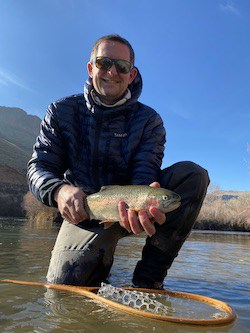How Many Fly Rods Do I Need?
October 1st, 2023
When it comes to fly fishing, there’s a lot to think about, and plenty of decisions to be made. The purpose of this article is to explain how many fly rods you’ll need, and for what purposes.
The answer will vary, depending upon what type of fly fishing you prefer, and the species you target.
But rest assured, I’ll explain things in a simple way so that you understand everything thoroughly.
And with that, let’s get started!

How Many Fly Rods Do You Need?
This is a bit like asking how much a house costs. It depends.
But don’t worry, the answer isn’t complicated at all.
Some folks overcomplicate things, and that’s doubly true within the fly fishing community.
Here’s what I can tell you right off the bat, before we get into any detail.
If you’re a freshwater fisher and you prefer casting dry flies or small streamers, swinging wet flies, and/or drifting nymphs, you really only need one fly rod. That rod would be a 9-foot, 5-weight.
A 9-foot 5-weight fly rod is absolutely the most versatile option for freshwater fly anglers. Rivers, lakes, streams–it doesn’t matter. If you focus on freshwater species, this rod will get the job done 95% of the time.
In the picture above, and below, are brown trout I caught on my primary 9-foot 5-weight Scott Centric fly rod. It’s my primary rod and I use it for almost everything here in Idaho.
There’s only one caveat to all my answers: I always recommend having at least one backup rod because you will break or damage your primary rod at some point.
So, the simple answer is you really only need one fly rod (plus a backup) if you’re sticking to the basics. However, in the below sections I’ll explain why you might want to consider adding to your rod collection.

Do I Need a Streamer Fly Rod?
If you’re going to get serious about throwing streamers (aka “tossing meat”), you’ll want to add a dedicated streamer fly rod to your collection.
A 9-foot 5-weight can handle small streamers, weighted or unweighted, but if you want to add bigger streamers to your fly box you’ll want a stronger rod.
Here’s why.
Streamers are generally heavier than dry flies, nymphs, or wet flies, and they create more wind resistance.
A stronger rod will do two things for you.
First, the rod will allow you to cast your streamers farther distances.
Second, the rod will allow you to cast into and through the wind with less effort.
Which streamer rod is ideal?
I’d personally recommend a 9-foot 7-weight fly rod for streamers. That’s what I use.
In the below picture, I’m holding a relatively heavy streamer that’s best cast with a more stout rod, as I mentioned above.

Do I Need a Saltwater Fly Rod?
If you plan on fishing in the salt, you’re not going to want to use the ultra versatile 9-foot 5-weight. It’s just not a strong enough rod for the giant flies and stiff winds that go along with saltwater fly fishing.
However, the absolute best saltwater fly rod in terms of versatility is without question the 9-foot 9-weight.
I’ve caught everything from ladyfish to giant redfish with my 9-foot 9-weight and it’s just a fantastic saltwater rod. Unless you’re going after monster bluefin tuna offshore, just get yourself this rod and you’ll be glad you did.
Here’s a picture of a nice redfish I caught using my trusty 9-foot 9-weight. If you’re interested in saltwater angling, don’t miss my article on fly fishing for redfish.

A Dedicated Nymphing Rod?
Some hardcore nymph anglers will tell you to get a 10 or 11 foot fly rod to help manage your line more effectively.
I’d only recommend this if you’ve got money to spare, or you’re planning on spending almost all your time drifting nymphs.
Otherwise, a 9-foot 5-weight will do just fine for nymphing in most situations.
How Many Rods is Ideal?
Only you can answer this question, but I’ll give you my perspective.
Here are the rods I own and why.
7.5-foot 3-weight
This rod certainly isn’t necessary, but it’s a nice luxury for small streams and rivers that don’t have as much room for casting.
The shorter rod helps me avoid hitting branches and brush during my casts, and the lighter weight gives me greater feel casting short distances, such as in pocket water.
You can absolutely use a 9-foot 5-weight (the all-around best fly rod for freshwater) in tight quarters, but as Ferris Bueller once said, “If you have the means, I highly recommend picking one up.”
9-foot 5-weight
This is the all-around best fly rod for freshwater fishing. Period. End of story.
I’ve got two of these, in case one snaps.
I use this rod at least 90% of the time I’m fishing.
9-foot 7-weight
This is my dedicated streamer rod. I’ve got full sinking line on it, and it casts heavy patterns like a dream.
9-foot 9-weight
This is my dedicated saltwater rod, and I think it’s without question the best all-around saltwater fly rod.
Summary
There you have it–that’s my attempt at answering the question of how many fly rods you need.
If you want to cover all your bases, get yourself four rods (listed above).
Regardless, the 9-foot 5-weight fly rod is so versatile that if you only get one freshwater rod, this should be it.
Just remember to have a backup rod available. It’d be a real bummer to snap your sole rod in the door after you’ve driven two hours to the river.
Check out some of my other articles including fly fishing for brown trout and interesting things I’ve encountered while fly fishing.

About the Author
My name's Sam and I'm a fly fishing enthusiast just like you. I get out onto the water 80+ times each year, whether it's blazing hot or snow is falling. I enjoy chasing everything from brown trout to snook, and exploring new waters is something I savor. My goal is to discover something new each time I hit the water. Along those lines, I record everything I learn in my fly fishing journal so I can share it with you.
Follow me on Instagram , YouTube, and Facebook to see pictures and videos of my catches and other fishing adventures!


